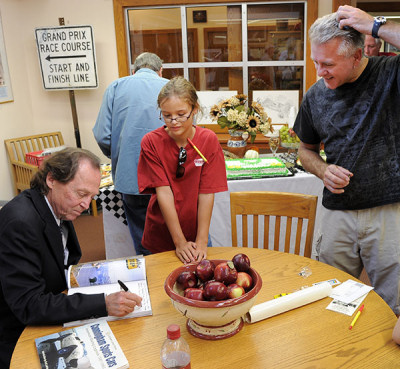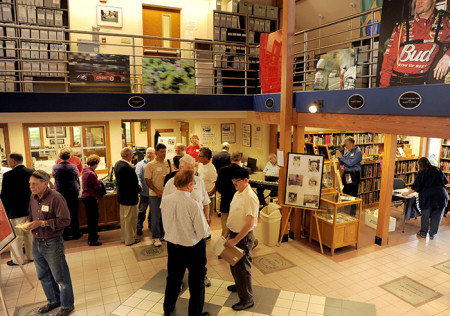The Way It Is/ Formula One at Watkins Glenby Gordon Kirby |
 I had the pleasure to spend most of this year's Columbus Day weekend in Watkins Glen. I drove out amid glorious fall weather with my friend Gary Gold to attend the 50th anniversary of the first United States Grand Prix at the Glen. The event took place at the International Motor Racing Research Center and we were there at Michael Argetsinger's behest to talk about Mario Andretti. Argetsinger had invited Ferrari expert Michael Lynch and myself to speak about America's two world champions--Phil Hill in 1961 and Mario in '78.
I had the pleasure to spend most of this year's Columbus Day weekend in Watkins Glen. I drove out amid glorious fall weather with my friend Gary Gold to attend the 50th anniversary of the first United States Grand Prix at the Glen. The event took place at the International Motor Racing Research Center and we were there at Michael Argetsinger's behest to talk about Mario Andretti. Argetsinger had invited Ferrari expert Michael Lynch and myself to speak about America's two world champions--Phil Hill in 1961 and Mario in '78.
The IMRRC was founded by Michael's father Cameron Argetsinger who passed away in 2008. The senior Argetsinger was the driving force behind the creation in 1948 of the original Watkins Glen open road races. Subsequently, for twenty glorious years between 1961-'80, Argetsinger brought Formula One to the permanent circuit opened in 1956 at the top of the hills overlooking the village and southern tip of Seneca Lake. The first race on October 8th,1961 was won by Innes Ireland who scored his first and only Grand Prix victory that day although he won eight non-championship F1 races between 1960-'64. It was also the first world championship Grand Prix victory for Team Lotus but turned out ot be Ireland's last race with Team Lotus as Colin Chapman fired him a month later in favor of Ireland's gifted young teammate Jim Clark.  © Gary Gold The Research Center is located at 610 South Decatur Street in Watkins Glen one block east of Franklin Street (Route 14) the village's main street. You can call the IMRRC on (607) 535-9044 or go to their website www.racingarchives.org. I highly recommend a visit for any race fans who find themselves in the area. We celebrated the 50th anniversary of Innes Ireland's historic win at the IMRRC on a fine afternoon amid superb Indian Summer weather. Michael Argetsinger signed copies of his excellent new book 'Formula One at Watkins Glen' published by David Bull. He also introduced Michael Lynch and I prior to our speeches about Phil Hill and Mario but before Lynch and I spoke Michael had a surprise for us in the shape of Bill Sadler. Back in the late fifties and early sixties Sadler built and raced a series of big-bore sports/racers. He was a proponent of stuffing big American V8s into lightweight European-style chassis and was one of the independent thinkers from those days who paved the way to the creation of the original, unlimited Can-Am series. A youthful 82, Sadler talked about racing his cars in the Libre races at the Glen in 1958, '59 and '60 and related a story about Stirling Moss asking to take a few laps in his powerful car. A Canadian who now lives on the Oregon coast, Sadler quit racing in 1962 to go into the electronics and aircraft businesses. Michael Lynch then took to the stage to speak about Phil Hill who won the World Championship in 1961 driving one of the legendary 'sharknose' 1.5-liter Ferrari type 156s. Hill became the first man to lap the Nurburgring under nine minutes when he took pole for the German GP as he battled for the championship with teammate Wolfgang von Trips. But Trips was killed on the second lap of the following month's Italian GP when he tangled with Jim Clark under braking for the Parabolica and crashed into the crowd. Hill went on to win the race drafting clear of the rest of the field in company with teammate Richie Ginther and not learning of von Trips death until after the race. Hill thus won the championship in tragic circumstances resulting in Enzo Ferrari withdrawing his cars from the season-closing race at Watkins Glen. Phil was present at the Glen, but only as a camera-toting spectator.  M. Artgetsinger signing a book for young race fan. © Gary Gold During his years driving for Ferrari in Italy Phil loved to go to the opera at La Scala and after retiring from racing he became an excellent writer for Road & Track, testing and evaluating vintage and classic cars. Michel Lynch was a close friend and Lynch told those of us gathered at the IMRRC that Hill's post-racing career marriage to Alma made him a less private and possessed man, much more relaxed and open with people. For those of you who missed it I suggest reading Sam Posey's excellent story about Phil titled 'A Man Like No Other' in the September issue of Road & Track. Hill's record includes one world championship, three F1 wins, thirteen more F1 podiums, three Le Mans wins between 1958-'62 with Olivier Gendebien and three Sebring 12 hour wins in 1958, '59 and '61, all in factory Ferraris. He also scored the only Can-Am win for Jim Hall's Chaparral team at Laguna Seca in 1966 aboard a 2G. Also in '66, Hill won the Nurburgring 1000Ks co-driving a Chaparral 2D with Jo Bonnier and on July 30th, 1967 he drove his last race, winning the Brands Hatch Six Hours with Mike Spence aboard a winged Chaparral 2F. As Michael Lynch said in his talk about Phil at the IMRRC: "Through the rest of his life, Phil was very proud of winning his last race." While Hill grew up amid a prosperous California family, Mario Andretti's family emigrated to America in 1955 after losing their land and most of their possessions during WWII. Soon after the family settled in Nazareth, Pennsylvania, Mario started his racing career with his brother Aldo, sharing a home-built 1949 Hudson stock car. Mario quickly fought his way up the ladder through stock cars, quarter-midgets, midgets and sprint cars, ultimately winning the Indy 500 in 1969 and the world championship in '78. Of course, Hill and Andretti won their championships in eerily similar circumstances seventeen years apart at the Italian GP at Monza when their respective teammates--Wolfgang von Trips and Ronnie Peterson--were killed. It's an intriguing footnote to their titles that emphasizes how deathly dangerous racing was in those days. The whole story of Andretti's career is told in my 2001 book, 'Mario Andretti, A Driving Passion', including the tale of him taking the pole for his first F1 race driving a Lotus 49 at Watkins Glen in 1968. Mario won his first Grand Prix in South Africa in 1970, driving for Ferrari, and finally made his run at the world title when he joined Lotus again in 1976 to help develop the revolutionary JPS Lotus 78 and 79 ground-effect cars. Andretti is one of the most versatile drivers of all-time, of course, winning on the dirt in midget and sprint cars and in Indy cars, Formula One, long-distance sports cars and NASCAR stock cars. Mario's record includes the '78 World Championship, four Indy car titles (in 1965, '66, '69 and '84), 51 Indy car victories, 12 F1 wins and seven world championship long-distance sports car wins highlighted by one Indy 500 win (1969), one Daytona 500 ('67) and three Sebring 12 hour victories (1967, '70 and '72). He was also IROC champion in 1979 when that series was at its height.  Interior at racing center © Gary Gold Following our talks in the adjacent elementary school auditorium about Phil and Mario we moved back to the IMRRC where Michael Argetsinger signed copies of his book and we enjoyed an afternoon of wine, cheese and good conversation. Both Michael and his brother Peter raced single-seaters in Europe. Michael was there between 1966-'76 and Peter raced Formula Fords and FF2000s in Europe a decade later during Ayrton Senna's time in those categories. Today, Peter is one of America's top driver coaches and career counsellors. During the sixties Michael also worked as a go-fer for the Cooper F1 team and served as his father's direct contact with the F1 teams and drivers. Nobody enjoys more intimate knowledge of Watkins Glen and its F1 days and in his book Michael provides a real insider's view of F1's twenty years at the Glen. He's also assembled a fine selection of photos from many sources including the IMRRC and the Argentsinger family collection. 'Formula One at Watkins Glen' is a must-read that belongs in any serious race fan's library. One photo in particular in the book caught my eye. It's a great black and white shot of the start of the 1961 race. Jack Brabham is taking the lead from pole in his Climax V8-powered Cooper with Graham Hill's BRM to his outside. Inside Brabham, Stirling Moss is slightly crossed-up coming off the line in his Rob Walker Lotus and Jim Clark darts to Moss's inside within a few feet of a cluster of photographers and a couple of policemen with not a length of guardrail to be seen. Different days, to be sure. My visit to the Glen roused a certain sadness about the loss of the great track as an international racing venue. The track fell into bankruptcy following the departure of F1 and was bought first by Corning Glass, then by ISC, and since 1986 the Glen's big race has been a mid-summer NASCAR Sprint Cup race. Vic Franzese and his family are the proprietors of the Glen Motor Inn. Vic is a longtime amateur racer and one-time Can-Am team owner and he believes F1's departure from the Glen in 1980 presaged not only the decline of the Glen as an international racing venue but also the beginning of the decline of international racing as a whole in America.  Michael A. and GK on podium © Gary Gold It's also worth reflecting that Indy car racing tried to make it at Watkins Glen in two different eras--during CART's formative days and more recently under IRL/IndyCar. CART ran at the Glen for three years--1979, '80 and '81--but the crowds were modest even with recent world champion Andretti spicing up a field that enjoyed Indy 500 winners Bobby and Al Unser, Rick Mears, Johnny Rutherford and Gordon Johncock. A quarter of a century later, with much less name recognition for its star drivers, the IRL tried racing at the Glen from 2005-'10. But that experiment failed too as have more than forty other CART/Champ Car/IRL/IndyCar races over the past fifteen years. All of which is a stark contrast to the massive following enjoyed by F1 during its memorable 20-year run at Watkins Glen and it was a pleasure to celebrate those days on Columbus Day weekend. Again, be sure to buy Michael Argetsinger's fine book. All proceeds go to help support the IMRRC and you will surely be delighted with your voyage through the fifties, sixties and seventies at Watkins Glen. Great days in many different ways. *All of us were shocked at Dan Wheldon's death in Las Vegas on Sunday. Our deepest sympathies go out to Suzy Wheldon and to Dan's father and family. I've written a blog about his fatal accident at Motor Sport's website, www.motorsportmagazine.co.uk. |
Auto Racing ~ Gordon Kirby Copyright 2011 ~ All Rights Reserved |
